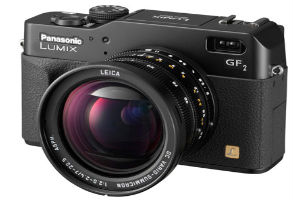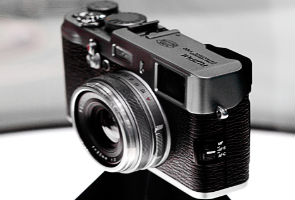[ad_1]
If you want some thing more hard, harmony the countrywide spending plan.
But if you truly want a head-pounder, try generating a very small camera with a big sensor.
The dilemma is physics. A massive sensor documents remarkable light-weight, color and detail. But to flood its floor with light, the lens has to be massive and be a selected distance absent.
That is why, for several years, there were two sorts of cameras: pocket designs, with small sensors that make blurry or grainy photos in small mild and S.L.R. cameras, these major-sensor, huge-system, weighty black beasts utilized by professionals.
In the very last few of a long time, though, things have adjusted. There is a new class of digicam whose size (both equally overall body and sensor) falls in amongst those two time-honored extremes. They represent a rethinking of each one style aspect, a jettisoning of each and every nonessential component, in pursuit of a little, huge-sensor digicam. Since that, soon after all, is what the earth actually needs.
Two of the smallest cameras but have just arrived: the Panasonic Lumix GF2 ($600 with 3X zoom lens) and Olympus E-PL2 ($520 with 3X lens). They’re both equally 12-megapixel Micro 4-Thirds cameras, a structure dreamed up by Panasonic and Olympus about a few yrs ago. All of these cameras have the similar-size sensor — not as big as an S.L.R.’s, but significantly even larger than a compact camera’s — and accommodate the same loved ones of lenses, now numbering about 20.
How little are they? Properly, the Panasonic’s entire body is 4.4 by 2.7 by 1.3 inches. Which is darned smaller. You have eaten brownies even bigger than this digital camera.
Panasonic suggests it’s the smallest interchangeable-lens digicam in the environment — with a flash. (Evidently, that’s a veiled reference to the even additional ridiculously little Sony NEX5, which lacks a developed-in flash.) The Olympus is only a fraction porkier.
Now, these cameras usually are not so smaller that you can have them dangling from your wrist or a neck strap you would break bones that way. But the physique unquestionably matches in a coat pocket or, with some discomfort, a pants pocket. It will match even with the lens on, supplied that the lens is a “pancake” (nonzooming) starter lens like the 14 millimeter one particular that comes with one particular of the Panasonic kits (it really is equivalent of a 28 millimeter regular camera lens).
In the close, you won’t be able to seriously cheat physics. Finding cameras this tiny suggests sacrifices. For instance, both of those of these cameras have a pop-up flash — and it pops way up higher, a trick that minimizes pink eye in your topics — but it can be weak, with only about a six-foot range.
You have entire manual controls, of study course, due to the fact these cameras are meant to be mini-S.L.R.’s. But there is certainly not nearly as significantly room on these cameras as on an S.L.R., so the buttons are compact, cramped and have multiple capabilities.
Panasonic’s solution: a touch display screen. That might appear like a excellent idea, due to the fact it gives the designers acres additional real estate for exhibiting controls. It also signifies that you can touch the place in the scene where by you want the digital camera to concentrate — a neat trick — and pan all over a zoomed-in image by dragging your finger.
The computer software is designed with fingertip-size, translucent buttons on the monitor — but sadly, they clutter the impression and often sit ideal where you want to faucet to focus. You can customize the icons, specifying which types seem and in what buy. But numerous tasks even now get too lots of actions. And, bizarrely, the touch-display planet finishes when you enter the main menu instantly you have to use the up/down arrow buttons to navigate.
The Olympus digicam utilizes a additional classic 4-way controller, surrounded by a turning ring. It is all very small, while, and it’s easy to click buttons accidentally when you’re turning the ring.
An additional sacrifice: there is not significantly room in that very small body for a major battery. You can expect to get about 300 shots on a charge from these cameras, which is at the lower, minimal stop.
The even larger reduction is the optical viewfinder. Each cameras have dazzling, beautiful three-inch screens that do O.K. in sunlight. But they are nowhere in close proximity to as great as the eyepiece of a frequent S.L.R., in particular in lower mild. The big difference in clarity and experience is specifically apparent when you compare one particular of these Micro 4-Thirds cameras with an S.L.R. aspect-by-facet.
Each Olympus and Panasonic are happy to offer you an electronic eyepiece viewfinder that snaps onto the major of the digital camera. But it charges a large amount: $200 for the Panasonic, $250 for the Olympus (a $100 optical glass a single is also readily available). It also fills up the hot shoe where you may have attached a microphone or flash, and besides, it truly is dishonest. Your tiny digicam is considerably less tiny if it has a significant doodad sticking up from the best.
None of this is to say that these aren’t excellent cameras — they are. Indeed, you make some sacrifices. But you do certainly get the holy grail: a very small camera with a major sensor within. And the pics make it all worthy of it. They are bright, wonderful, apparent and extensive, and you can get that lovely blurred-track record effect that’s widespread in professional portraits. (You can see some samples in the slide demonstrate that accompanies this short article on The Instances Website web page.. )
These cameras are seriously great at video clip, far too. Each individual has a focused Report/Prevent button, so you you should not have to improve modes just to commence taking pictures. Each file in higher definition: the Olympus is 720p, the Panasonic is 1080p, though you truly can’t see any distinction. Both equally cameras supply some tacky particular results that perform both of those in nevertheless and movie manner.
Both of those of these cameras can effortlessly alter emphasis, promptly and superbly, whilst you are capturing online video — if you zoom or pan to one thing nearer, for instance. That’s scarce in S.L.R.-kind cameras. This approach just isn’t as fast or trustworthy as it is on a camcorder — gigantic shifts in length at times baffle the refocusing system — but in excess of all, it performs perfectly.
Now, even while these cameras have S.L.R.-like characteristics, they are not real S.L.R.’s. Initial, they are not just about as superior in low light. The sensor inside is a lot even larger than a compact camera’s, but it’s not S.L.R.-size.
Next, simply because of the mirror-significantly less Micro 4-Thirds design and style, these cameras aren’t as quick to target as a genuine S.L.R. Depending on the zoom level and the lighting, the Olympus, in certain, from time to time struggles to focus you can see it “searching,” alter the lens in and out as it attempts to determine out what is actually likely on.
That isn’t going to happen as frequently on the Panasonic. Above all, it really is the nicer digicam — it has stereo mikes as a substitute of mono, it is aluminum rather of plastic, and it has a rotation sensor for righting shots you took with the digital camera on its side — but it is really $80 more expensive, way too, and its photographs are more likely to require colour correction.
(It also accepts a new Panasonic twin lens that takes 3-D pictures, for playback on a 3-D Tv set — but it would not zoom, will not do the job in video manner, won’t function in reduced light-weight and will take only 1.4-megapixel photographs.)
And it can be not obvious that Panasonic has trumped its apparent concentrate on, the Sony NEX-5. That digicam lacks a developed-in flash, but its screen has two times the clarity (and it tilts), the overall body is smaller and the sensor is larger — as huge an S.L.R.’ s– so the pics are far better. On the other hand, only three lenses are accessible for the Sony, and its menu process is hopelessly inefficient.
These miniature Micro 4-Thirds cameras price tag as a great deal as a genuine S.L.R., and they teem with compromises. Continue to, if the planet craves a answer to the tiny digital camera/significant sensor challenge, these products present some novel answers to the puzzle.



